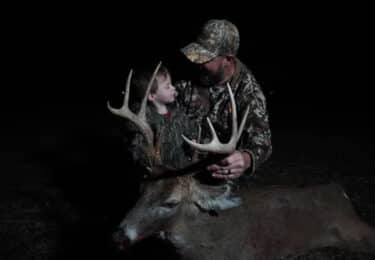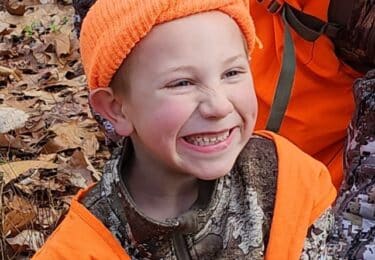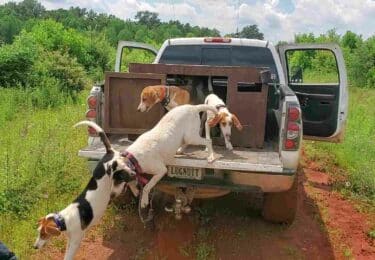Tainted
Would you eat meat that has been grazed over by a scavenger such as a coyote or fox? I was faced with this question when I decided to take a doe that was quartering towards me this past winter and my experience can possibly help answer this question. After all, I ate that deer and I’m still alive.
Deer Camp
I was the only person in deer camp when my Chevy crunched the frozen leaves beneath its tires. I had left work early and the plan was to get into the woods as soon as I could and hopefully, if fate would allow, have a deer hanging when the hunting party arrived. I quickly pulled on my camouflage long sleeve and lingered a minute while debating whether or not I needed heavier pants. The temperature was dropping and a small amount of snow had fallen hours before. I decided against the pants and started my journey to a large ground blind my dad had built. As soon as I reached the blind, opened the door and looked inside, I realized I had made the right call regarding pants. There was a little heater sitting in the blind with a full tank, this was going to be a comfortable hunt. The blind I had chosen sat high above a food plot with quite a few old growth hardwoods reaching up in front of it and scattering down to the clover plot.
These trees allowed excellent coverage but did add a challenge, most of the trees at some point or another cut off a shooting lane to the plot. A few hours later dusk approached I noticed movement about two hundred yards in front of me down in a small tall-grass swamp by the end of the plot. A few does were beginning to make their way out of the thick grass and onto the neatly grown plot. This was exactly the scenario I had hoped for; I wanted to see a group of does so I could pick out a mature animal. In my opinion, it is much easier to tell which doe may have a little more meat on her bones when they are all lined up side by side. After I watched the deer graze and play on the food plot for about fifteen minutes, I had made my decision. There was a dark colored doe hanging in the back of the group and when she maneuvered in and out of the small herd I could see she was in fact larger than most of the other game. This was to be our target once a proper shot revealed itself.
The Shot
Looking for a proper ethical shot is something any hunter should and will do. I have had my fair share of improper shots and I have lost deer because of that. My mind, having been tainted by these past experiences, pushed me to wait a little longer than I should have while this doe approached. She worked her way up the hillside that led to the blind; this hillside was littered with acorns, a food source she was interested in over the clover on the plot. The movement of the doe up the hill also put her at a tough angle. She was basically facing me with a small amount of her front shoulder visibly shown, there was not a broadside shot available. I lifted my rifle and placed the cross hairs on her front shoulder. At this angle I began to calculate where the bullet would enter and exit, this angle seemed appropriate to provide a kill shot. A crack from the end of my barrel scattered the herd and I saw the doe ran into a thicket. Believing my calculations to be correct I walked to the last known location of the doe. When I approached the does last known location, I found a small amount of blood. My shot seemed to be true; this should be an easy track.
At that moment my phone lit up, a member of my hunting party had arrived and offered to help me track. I left the blood trail where it lay and went to acquire some help. After a short exchange of pleasantries we arrived back at the last speck of blood and started to trail the doe. A long walk through thick pine and sapling forest had us tracking on our hands and knees for over an hour. Although we had only gone a small distance, the thick nature of the foliage created a misconception of distance, we believed we were further than we had gone. After approximately one hundred and fifty yards of tracking my partner raised his hand, he thought he heard something move. Trusting his ears and believing there was a good chance this doe was still alive, my mind immediately went back to that tough shot. My calculations must have been incorrect, my shot placement was not as true as I had intended. My heart dropped into my stomach.
Sometimes it’s Good not to Push the Envelope…
We decided to pull out of the track and give the woods a few hours to settle. The general thought for a waiting period on tracking a wounded deer seems to be 12-24 hrs. depending on who you talk to. Even then a hunter could walk up on a wounded deer and push it off the property never to be seen again. I constructed a plan to go back out after twelve hours and resume the track. Sometimes the best laid plans will go awry; unfortunately a broken alarm clock would not allow me to break my slumber that night. I awoke the next morning around 5:15 A.M in a panic, the first thought on my mind was, “can I find this doe?” Another member of our hunting party had arrived in the night and suggested I sit the morning hunt and then resume the track. I dressed that morning with a pit in my stomach and couldn’t see myself shooting another deer without being able to add finality to last night’s hunt. With most of the party hunting another piece of property, I made that mornings sit very short. I hopped down out of the blind I had taken the shot from the night before and immediately hit the blood trail. In the daylight tracking the dark blood was a lot easier. A short jaunt through a cedar swamped lead me to a mosaic of red colored leaves and snow, approximately forty yards from our stopping point the night before was where the doe had expired.
It’s impossible to know if a continued tracking party would have found this deer or pushed this deer off of our property. I’ll probably never know the answer to that question but none of that mattered as I had found my quarry and work needed to be done. When I walked up to the doe I noticed some scavengers had located her before me. A small hole was eaten in the rear, as most meat eating animals often do but the deer was generally intact. I called the hunting party and they all agreed to stop their pursuit and help me drag this large doe out of the swamp. Once we had pulled the game from the woods I had to ask myself. Would there be enough meat on the eaten hind quarter to keep? After I had the doe skinned I could clearly see the damage done by some scavenging predators. From this anatomical point of view I was able to construct a plan to salvage most of the meat. The damage had not gone as wide as I thought.
Is Meat Good for You?
A few questions weighed on my mind while I quartered the deer and cut up the hunks of meat that were free of bite marks. If an animal did eat on this deer what are the implications of eating this meat? After all, the deer was likely dead when it was scavenged and the chances of some form of bacteria being transferred throughout the entire animal are low. Not to mention most hitchhikers would be killed off in the cooking process. No blood flow likely meant there wasn’t a way for any form of bacteria or infection to spread to other parts of the animal. This leaves us with the hind quarter that was tainted. How far away from those bite marks do I need to be to assure I won’t catch rabies or some other communicable disease? I decided on two inches of cut around all bite mark affected areas. This left a good amount of muscle between any possibly contaminated meat and meat that would be clean.
The only evidence I can offer as to if this was safe or not is the fact that I am writing this article today. I ate every part of that deer and did not fall sick once. A hunter could experience a wide array of pin balling opinions on the subject from many blog sites but I will say this. If the majority of the animal is intact and you can leave two inches of good intact muscle between your meat and the bitten portions, I would be hard pressed to waste that meat. I won’t be the one to tell you what to do with your kill but I will be the one to tell you I did eat a “tainted” deer and lived. I’ll probably do it again if I’m unlucky enough to find a deer on the second day of a track.
Note: The temperature dropped to 23 degrees Fahrenheit that night so I knew the meat would not be spoiled from failing to clean the deer that night. Temperature is very important when determining if meat will be safe to eat, not only from the scavenged portions but the entire animal itself. It’s important to use your best judgment here.
To follow more of Grant’s work you can find him on IG at Carnivor3_hunter
You can follow more of what we have going on at Cervicide at Deer Slayer TV and on IG at CERVICIDE






